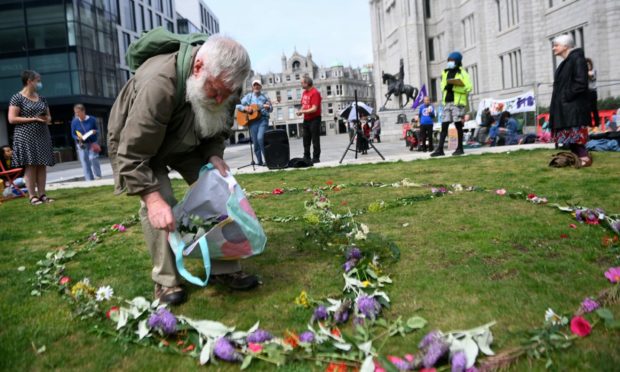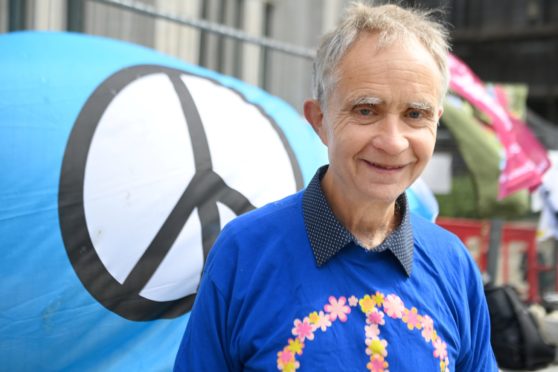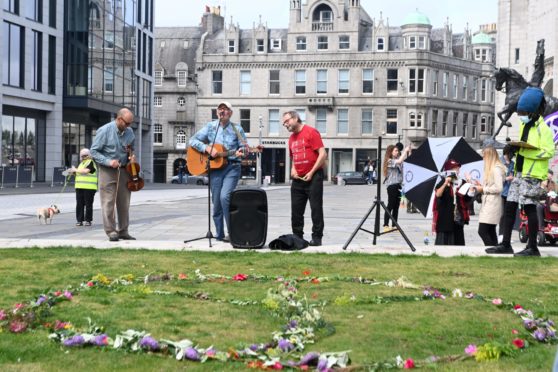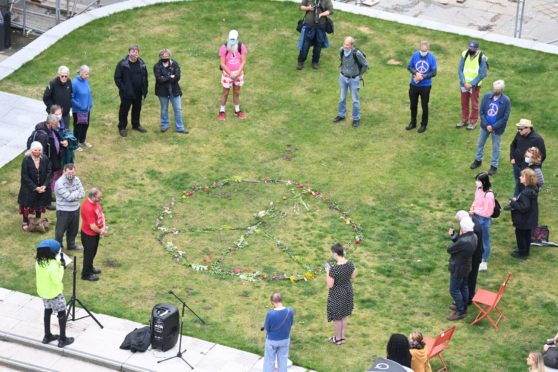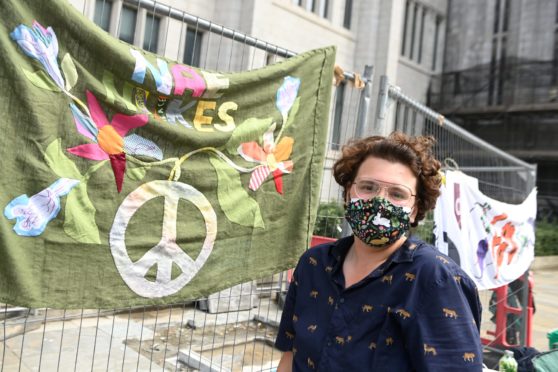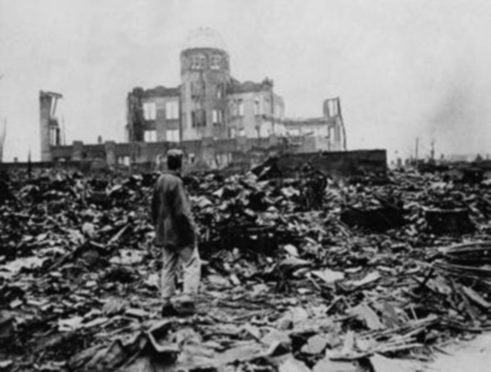76-years-ago, the US detonated two bombs over Hiroshima and Nagasaki.
It’s estimated that up to 226,000 people died as either an immediate result of the bombings, or in the following days, weeks and months due to radiation poisoning.
Today, almost eight decades on, tens gathered outside Marischal College in Aberdeen city centre to pay their respects and commemorate the events of August 6 and 9.
Honouring survivors while remembering those who lost lives – members of CND North East Scotland (Campaign for Nuclear Disarmament) created a peace symbol out of flowers.
The group also held a two minute silence to both “reflect and pray for individuals who paid a heavy heavy price” and to “pray for surviving families to give them strength”.
Members of the group went on to read poems while local musicians performed.
‘It could happen again’
It is the 14th year that CND North East Scotland chairman Jonathon Russell has held a Hiroshima and Nagasaki remembrance event in the city, saying: “we need to make people aware that it could happen again”.
He said: “It is highly important to remember Hiroshima on a day like this because these people died and it makes us remember how people suffer from nuclear weapons.
“We also hold this event to make people aware that it could happen again – and if it did happen again it would be much worse.”
Mr Russell said he became passionate about the cause as a young man when the Vietnam war took place.
He went on: “We have a number of aims really, but primarily to get rid of nuclear weapons in Scotland and worldwide.
“I’ve been to Faslane where the nuclear weapons are kept in Scotland and the institution there is horrifying.”
During the commemoration, Mr Russell read out a speech from Aberdeen University lecturer Yu Aoki, who is currently visiting her hometown of Hiroshima.
During the speech, Ms Aoki paid respect to the lives lost in her hometown and told the story of Shigeru, a 13-year-old boy who died during the bombings.
Story of Shigeru
“On August 6 1945, it was a beautiful morning with no clouds in the sky, and people had a relaxing start of the day,” her speech read.
“Suddenly, people saw a strong flash and were surrounded by dazzling white light.
“Everybody held their breath. At that moment the city of Hiroshima exploded.
“It was as if the sun fell from the sky. Buildings and houses were knocked down on the ground.
“On the morning of August 6, Shigeru’s mother Shigeko saw him off and passed him a little lunch box filled with rice, barley and soybeans.
“Shigeru waved his hand to his mum with smiles. This turned out to be the last time she saw her son alive.
“After the atomic bomb was dropped later in the morning, Shigeko searched for her son for three days and finally found him in the early morning of August 9.
“When she found him he was still holding the lunch box she had gave him.
“Shigeko burst into tears and told her son, ‘you didn’t manage to have the lunch mum made for you, did you?
“The lunch was carbonised due to the heat of the bomb and was later donated to the Peace Memorial Museum in Hiroshima by his family so that the tragedy would not be forgotten.”
Ms Aoki’s speech continued: “When people talk about nuclear weapons, they talk about how effective they are as a means of defending a country.
“But they rarely think about the actual consequences of using them. The story of Shigeru speaks about these consequences.
“A bomb takes away the lives of normal people leading normal everyday lives like us, it kills people located far away from the hypocenter by exposing them to radiation carried by wind and rain, and it causes damage to the fetuses of pregnant mothers.
“This is what it means to use nuclear weapons, and Shigeru’s story is just one out of 210,000 stories of the people who died because of the bombs in Hiroshima and Nagasaki.
“We cannot change the world overnight but it is possible for each of us to imagine what it means to use nuclear weapons, and make continuous efforts and choices to reduce them.
“Today my thoughts are with the people who lost their lives in Hiroshima and Nagasaki, and the victims of the ongoing conflicts across the world. Hiroshima never again.”
Food not Bombs
Local group Food not Bombs who “aim to collect and distribute food to anyone who is hungry in and around Aberdeen” also attended the service.
Volunteer Roman Berriman said: “What we are trying to do is raise awareness of the amount of money that goes on nuclear funding and just provide food for people.
“We find that it is almost criminal the amount of food poverty in general that is going around.
“We do what we can with what we have to feed people that live here.
“We try to reduce food waste as well so we get food donations from food banks and we get donations from supermarkets who have food they cant use.
“Some children are not fed at home, their parents don’t have enough money to feed them and I think that it’s criminal to have all this money going into nuclear funding – even if there was a war there is no need for nuclear weapons because they cause devastation.
“We want to raise awareness – even if someone goes home with a flier and doesn’t need the food but knows someone who does.
“We don’t judge even if you need four servings – we don’t care, take the food because otherwise it goes to waste.
“We are just trying to get food to people who need it.”
What happened in 1945?
Despite Germany having surrendered to allied forces in May, the Second World War continued in Asia as allies fought imperial Japan.
On August 6 1945, the US believed that dropping a nuclear bomb – dubbed ‘little boy’ – on Japan would force a quick surrender.
At least 70,000 people are believed to have been killed during the first blast which devastated Hiroshima.
In the coming weeks thousands more died due to radiation.
After no immediate surrender came from the Japanese, another bomb, named “fat man”, was dropped three days later over 250 miles away on Nagasaki.
Recorded deaths are estimates but it is believed that of Hiroshima’s 350,000 population, almost half were killed.
A further 74,000 are believed to have died in Nagasaki.
The explosions brought an end to the war in Asia with Japan surrendering to the allies on August 14, five days later.
The two bombings are the only two nuclear weapons to have been deployed to date outwith testing.
